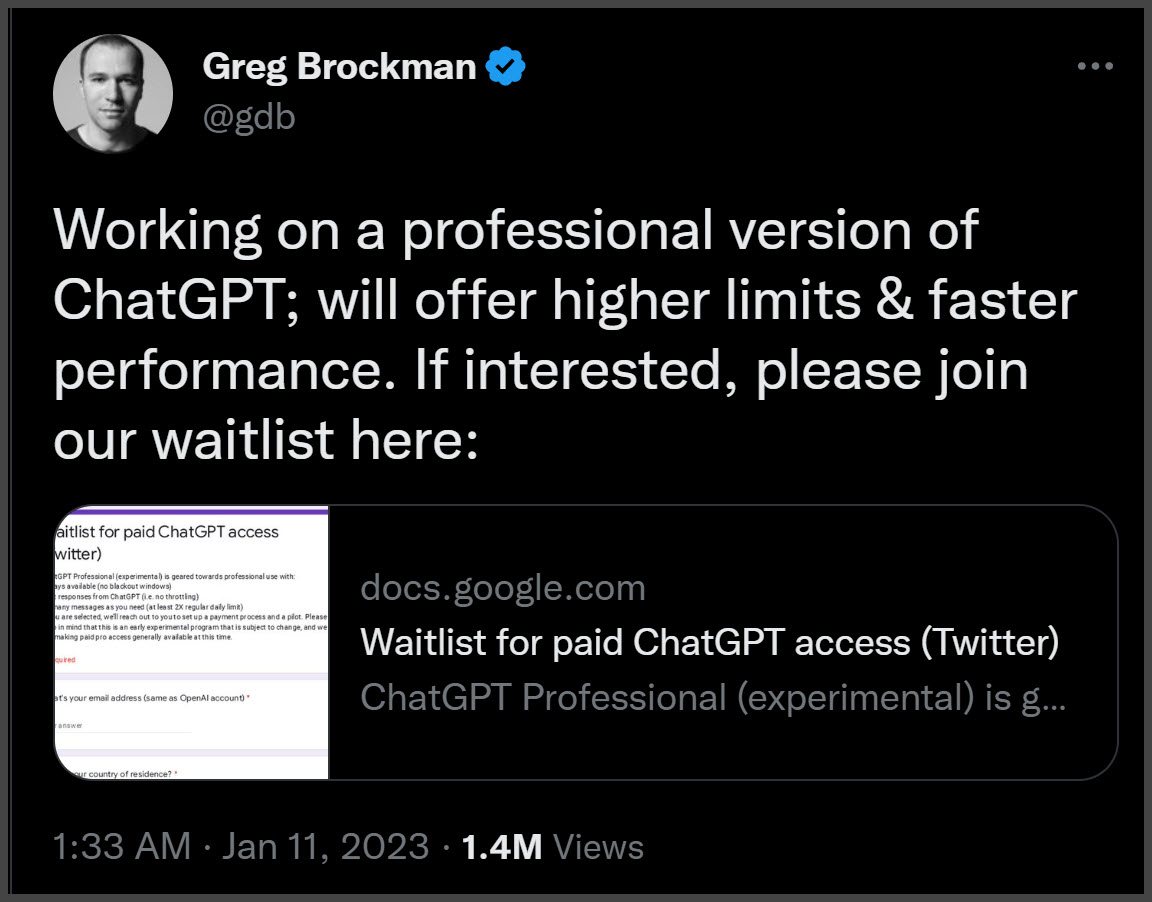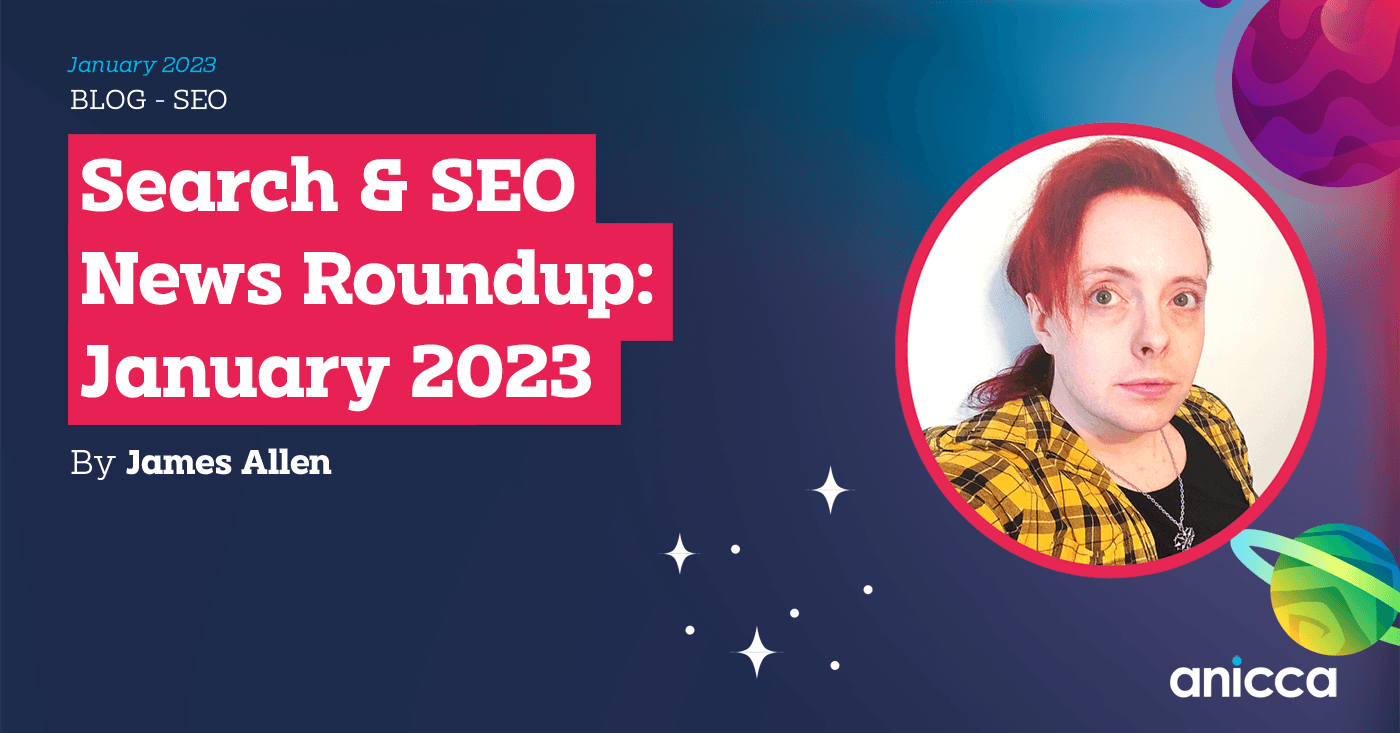Search & SEO News Roundup January 2023

What’s new in search this January? Google release new Cloud Platform AI Tools, SEOs adopt ChatGPT, Shopify release Commerce Components and more.
During January 2023, these are some of the highlights so far:
- New Google Cloud AI Tools for Ecommerce
- Google’s Helpful Content Update has Finished Rolling Out
- How SEOs are Already Adopting Open AI’s ChatGPT
- Greg Brockman (President of Open AI) Releases ChatGPT Pro Waiting List
- Microsoft Explore the Application of ChatGPT within the Office Suite
- Google’s Right to be Forgotten Interactive Video
- Google Agrees to Pay Up for 12 Year Class Action Lawsuit
- Commerce Components by Shopify Could Boost Conversion Rates
Read on for the low-down.
New Google Cloud AI Tools for Ecommerce
Posted January 13th on Search Engine Journal
This news will be of particular interest to those running or managing ecommerce websites, particularly those sites which leverage Google Cloud Platform infrastructure.
Google Cloud Platform is a suite of cloud computing products and technologies, which operate the same mechanics as Google’s front-end services (for example: Google Search, Google Drive, YouTube etc).
Google Cloud has announced the launch of numerous AI tools and assisted technologies, which are particularly of interest to enterprise-tier ecommerce providers. Amongst these new tools are a pair which can utilise AI to recommend products to users, and even re-arrange the product listings on a web-page.
This could be very powerful technology for large ecommerce providers, who have thousands or millions of listed products. Ensuring that the most compelling products are placed in front of each user has always been a primary aim of both SEO and CRO (Conversion Rate Optimisation).
With more AI-assisted technologies available to dynamically re-arrange products and content; the struggle to convert users should become much easier. In the future, trying to satisfy all users with a single product or page-layout, could be a thing of the past.
Main takeaway: enterprise-tier ecommerce site owners (or managers) might wish to look into Google’s new suite of AI-assisted cloud tools. Some of them seem like they will be extremely powerful (from a conversion-boosting perspective).
Google’s Helpful Content Update has Finished Rolling Out
Posted January 12th on Search Engine Land
Google have now confirmed that their helpful content update (released December 2022) has now finished its roll-out. You can find a list of Google’s search updates here:
https://developers.google.com/search/updates/ranking
You will note that the Helpful Content update has seen more than one release. This latest information from Google confirms the completion of the December Helpful Content update.
You will also see that Google have recently completed the roll-out of a Link Spam update, which also dates back to December 2022.
So, what is the Helpful Content update about? Here is some information, directly from Google:
“The helpful content system aims to better reward content where visitors feel they’ve had a satisfying experience, while content that doesn’t meet a visitor’s expectations won’t perform as well.
The system generates a site-wide signal that we consider among many other signals for ranking web pages. Our systems automatically identify content that seems to have little value, low-added value or is otherwise not particularly helpful to those doing searches.
Any content—not just unhelpful content—on sites determined to have relatively high amounts of unhelpful content overall is less likely to perform well in Search, assuming there is other content elsewhere from the web that’s better to display. For this reason, removing unhelpful content could help the rankings of your other content.
This classifier process is entirely automated, using a machine-learning model. It works globally across all languages. It is not a manual action nor a spam action. Instead, it’s just one of many signals Google evaluates to rank content.
This means that some people-first content on sites classified as having unhelpful content could still rank well, if there are other signals identifying that people-first content as helpful and relevant to a query. The signal is also weighted; sites with lots of unhelpful content may notice a stronger effect.”
Essentially, these updates are similar to Google’s old ‘Panda’ content updates. However, rather than flagging potentially spammy content and referring it to a manual review process (do you remember Panda’s manual actions?); Helpful Content utilises the power of machine learning (and supporting algorithms) to automatically adjust search rankings. Sorry, there is no appeal process! Instead, try to follow Google’s content creation philosophies. You can read more about those here.
Main takeaway: check your rankings to verify any losses or gains against Google’s Helpful Content update. If you have suffered losses, re-familiarise yourself with Google’s content creation guidelines.
How SEOs are Already Adopting Open AI’s ChatGPT
Posted January 11th on Search Engine Journal
An interesting take on SEO implications and implementations from Search Engine Journal’s Brian Frederick. You can expect to see more commentary on Open AI’s ChatGPT from us here at Anicca over the coming months (in fact, there’s more within this very post later on).
So, what is ChatGPT? Essentially it is an interpretation engine which sits atop GPT-3. Whereas GPT-3 can listen to an input prompt and continue to build a body of text (in the same style), ChatGPT is different. ChatGPT can interpret contextual instructions within a user’s prompt, and then generate text and answers to suit.
You can actually get GPT-3 to build similar answers and bodies of text to ChatGPT, but it takes more input information and a lot more prompt-sculpting. ChatGPT is much better at interpreting subjective instructions and then feeding more complex instructions to GPT-3, to get the right output. ChatGPT also utilises Machine Learning to grow its own knowledge and increase the depth of its input model.
According to Brian Frederick, SEOs are already using ChatGPT to:
- Create content (this one should be obvious!)
- Assist with keyword research and analysis (particularly with regards to discovery and keyword categorisation)
- Help with ideation for content strategy development
- Help make determinations on search intent
- Generate SEO titles (and assumedly, other Meta sets like descriptions or H1s)
- Assist with the development and managing of Analytics reports
It’s important to remember that ChatGPT relies upon a large input model of text which only Open AI have access to. The update cycle for that model is currently thought to be yearly. This means that whilst ChatGPT is great at writing about well-known, established products, topics and themes – ChatGPT struggles to write around emerging information.
ChatGPT also (currently) doesn’t have access to the web or any information outside of its own model-based information system. Of course, we expect that Open AI are feeding ChatGPT with large volumes of flat web data and content.
The reason that this is important? You can’t point ChatGPT to a URL and ask it to write an SEO description for that page. What you can do is tell ChatGPT that you are feeding it text from a web-page, paste the page’s content, and then ask ChatGPT to write the SEO page title.
Main takeaway: There are many existing and future application for Open AI’s ChatGPT technology (which runs over the top of GPT-3) for SEO. Once GPT-4 is released, we expect ChatGPT to be connected to that engine (which is much more powerful and efficient). We can already see a time where AI will handle most smaller content snippets, such as on-page product descriptions for established products. For emerging products and services, it is likely that you will still have to author your own snippets of content.
Greg Brockman (President of Open AI) Releases ChatGPT Pro Waiting List
Tweeted January 11th on Greg Brockman’s Twitter
Very interesting news from Greg Brockman on Twitter, he is president (and co-founder) of Open AI:

Keep in mind that ChatGPT’s current free tool, is for evaluation / demo purposes. Despite being named “Open AI”, the named company primarily deals in proprietary software and technologies (rather than open-source). For example, if you want something similar to GPT-3 which is open source, you have to look to technologies like GPT-J instead.
It is almost certain that the evaluation (free) tool will be cut off, and that it will be replaced with API subscriptions, paid tools etc. We know that Open AI already charge for the use of their Open AI API, which handles programmatic requests for their various technologies. Once ChatGPT concludes its review phase, it will probably end up in there.
You can already install ChatGPT locally. To utilise ChatGPT locally, you need the Open AI API client and associated API keys / tokens. This means that even when running ChatGPT locally, you don’t actually have the main ChatGPT technology (i.e: the model) installed locally and you must still process requests to Open AI. This is in contrast to AI projects like ‘Stable Diffusion’ (an image-creation AI), where you can download and install the full technology (including pre-built training models) and run the tech without making requests to external machines or networks.
Since it appears that ChatGPT is gearing up to be a paid solution, you’d do well to sign up for their pro waiting list now (as Tweeted by Greg Brockman, same link). Because ChatGPT is aggressively defended against scraping, and because ChatGPT is still in its technical review phase, there currently isn’t any way to bulk-fetch ChatGPT for prompt responses.
Once ChatGPT is integrated into Open AI’s API, that will all change (but there will be an associated price).
Main takeaway: Get on the ChatGPT Pro waiting list now, so that you can leverage ChatGPT to its fullest extent, once the product matures. It won’t be long now. The number of applications for on-site content and SEO are almost limitless.
Microsoft Explore the Application of ChatGPT within the Office Suite
Posted January 9th on Search Engine Journal
Recently, we heard that Microsoft have made the decision to invest $10-billion (USD) in Open AI, the people behind ChatGPT. Talks regarding this investment are on-going. With this in mind, it’s to surprise to hear that Microsoft are now exploring the implementation of this technology within their Office suite of applications.
If you think about it, this makes a lot of sense. If ChatGPT’s model and technology is so advanced that it can answer queries directly (and accurately) – why would users still need search engines?
Okay, so this is a bit of an overstatement. For a start we know that ChatGPT struggles with recent news and events due to the update cycle for its training and data model. We also know that many search queries are navigational or transactional, and you can’t directly buy products via ChatGPT.
Obviously, there’s still a place for search engines. Currently it’s still a large area. When users want to undertake actions and make commercial interactions (transactions), ChatGPT doesn’t help much. But if you’re simply asking for the best restaurant in X area, or the list of movies for a certain actor / producer – then ChatGPT is very good at that kind of thing.
Even so, ChatGPT is likely to hold the potential to undercut Google for a number of informational queries. It’s also capable of producing information on command, presuming of course that the new information can be derived from historic information (contained within ChatGPT’s training model).
If Microsoft can integrate ChatGPT into Office, that’s just a stepping stone. Why not have ChatGPT integrated into Windows at the Operating System level? Remember in 2021 when Microsoft discontinued the Cortana (Microsoft’s virtual assistant) mobile apps for iOS and Android? Well, you can imagine the power which Cortana could wield once integrated with technology like Open AI’s ChatGPT.
Main takeaway: If Open AI will be the technological king of a brave new digital frontier… you can expect Microsoft to make a genuine attempt, to become the deployment medium for that technology. Only time will tell in terms of the possibilities.
Google’s Right to be Forgotten Interactive Video
Re-tweeted January 6th by Google Developers, re-tweeting Google Search Central (November 2nd 2022)
This video has been around since November 2022:
https://www.youtube.com/watch?v=vx0vVsgCiBM
However, Google Developers have recently (January 6th 2023) re-tweeted the video (originally shared by Google Search Central). This demonstrates that Google, across different departments, are still really passionate about reputation management education.

The video is interactive, and only lasts about ten minutes. We suggest that you play and interact with this video to learn more about Google’s “Right to be Forgotten” guidelines.
Essentially, the video highlights that where there is genuine public interest, the right to be forgotten doesn’t extend that far. Keep this in mind when engaging in reputation management activities, as (by and large) – Google’s perspective is usually to retain and to continue showing the information.
If we our or companies appear in the news, or in Google’s results for negative reasons, our personal bias dictates that the information should be removed. Google only agrees if there is no relevance of the information to the general public.
For example, if you are a politician and you make a prejudiced remark, don’t count on reputation activities having much impact (unless of course, you are going the pure-PR route of burying bad news with new, more positive news). If your business operates a warehouse and someone died via poor health and safety policies, again – don’t count on Google removing that information (since working for your company could be a health risk).
Main takeaway: Reputation management is a tricky game and should usually be left to purebred PR professionals. Even then, negative news can surface and resurface (on Google) against more recent positive news. In the end, the best way to manage your reputation is to maintain rigorous ethical and safety standards. Don’t get bitten in the first place.
Google Agrees to Pay Up for 12 Year Class Action Lawsuit
Posted January 5th on Search Engine Land
This is an interesting piece of news, since it may impact the way in which advertisers are able to operate in the future. Certainly, Google won’t like having to make large pay-outs. News like this often results in policy and technology changes, further down the line.
Details of the pay-out can be found here, and also here. Google must also disclose further information to consumers, in terms of how their search terms might be shared with third parties.
Here is some information from Bloomberg Law, in terms of the consumers’ complaints:
“Consumers claimed that when a Google user clicked on a link in search results, the site shared the search terms entered with third parties, potentially revealing personal information about the searcher. Advertisers pay Google to see what search terms led consumers to a particular page, according to the suit.
The suit alleged that Google’s data-sharing violated both the Stored Communications Act, a federal law that governs access to records held by internet service providers, and state laws in California.”
Essentially this seems to revolve around the existence of PID within search queries. Some users might search their own phone number or email address on Google, to see where their personal details have been listed. The search query, containing PID, may then end up within Google Search Console or Google Analytics for third parties to review.
Google already have policies against storing PII / PID within Google Analytics:
https://support.google.com/analytics/answer/6366371
Main takeaway: This class action lawsuit will only intensify Google’s efforts to keep PII / PID, out of their data centres and analytics platforms.
Commerce Components by Shopify Could Boost Conversion Rates
Posted January 3rd on Search Engine Land
Websites running Shopify, particularly those with an ecommerce focus, could soon see higher conversion rates. Shopify has introduced a composable stack of components designed specifically for enterprise-tier retail websites.
If you are interested, you can read more here, on the Shopify blog:
new items in Shopify’s arsenal include 1-click checkout and “99.99%” checkout up-time. Shopify often receives criticism from seasoned SEO veterans, especially with regards to poor page-loading speeds. It’s great to see that Shopify are continuing to innovate, especially on the session retention and conversion-rate optimisation ends.
Main takeaway: Shopify continue to innovate for retail, so that their product remains competitive.




